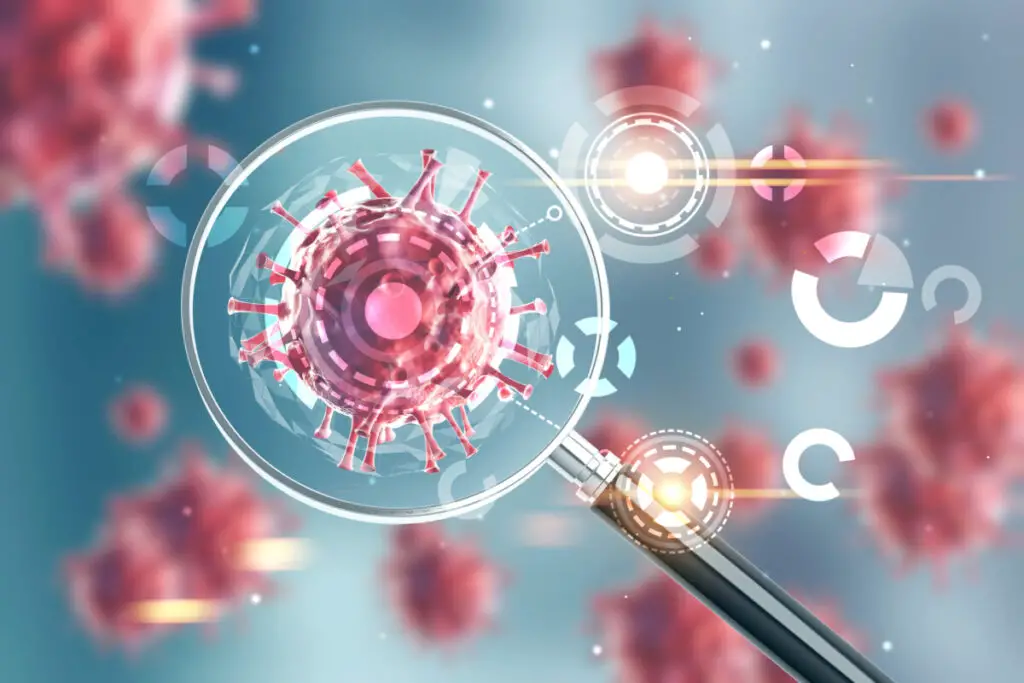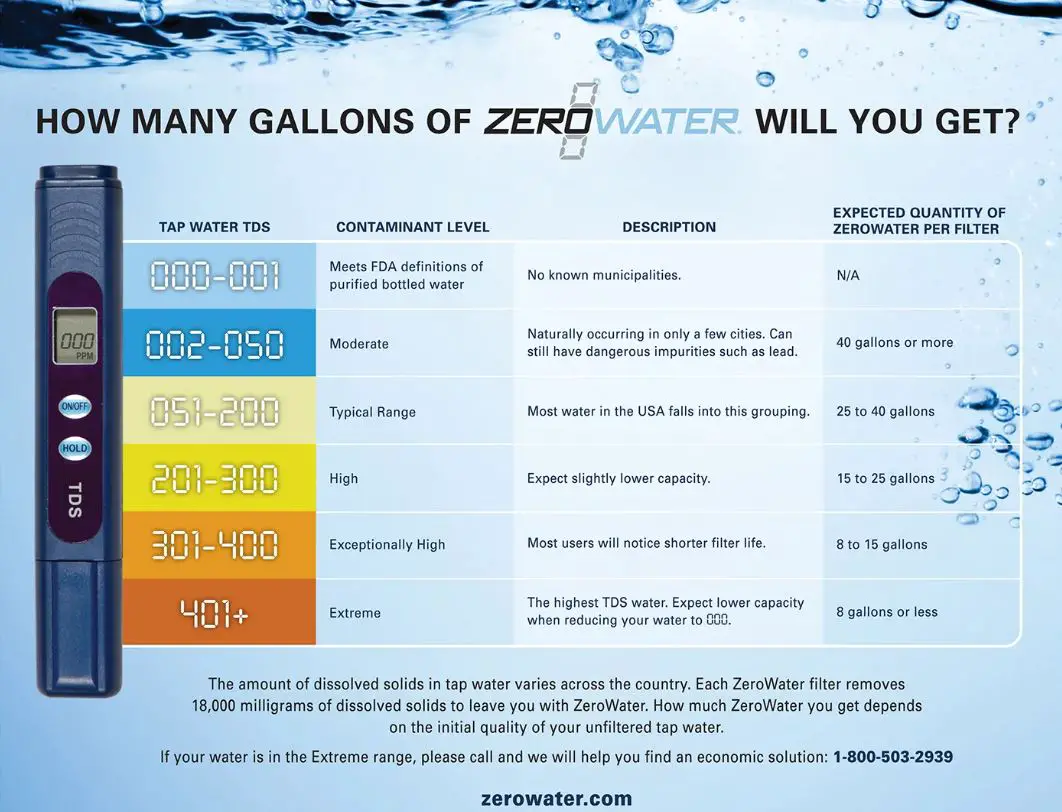ZeroWater prides itself on its removal of almost all dissolved solids (TDS) with its 5-stage filter. Despite this, many people still wonder if ZeroWater filters can also remove harmful bacteria and viruses from water.
ZeroWater filters are not able to remove bacteria, viruses, or other microorganisms from water. Although, these filters can remove almost all dissolved solids from water.
ZeroWater filters are still great filters and are good are removing many harmful contaminants from water, which we will cover in detail. We also explain which contaminants ZeroWater filters do not remove and which purification methods you can use to remove bacteria and viruses.

Can ZeroWater Filters Remove Bacteria & Viruses?
ZeroWater filters, along with almost all standard public-sale faucet, pitcher, or counter-top filters are not capable of removing bacteria or viruses from water.
These filters are not made from an antimicrobial material so they have no effect on bacteria and viruses.
Unfortunately, bacteria and viruses can quickly contaminate untreated and treated water.
In fact, bacteria in drinking water are a leading cause of disease outbreaks in the U.S., and viruses in water can remain infectious to humans for up to 10 months!
To remove both bacteria and viruses from water requires exposure to an antimicrobial media (like silver), or treatment using boiling water or ultraviolet light.
What ZeroWater Filters Can Do?
Although the ZeroWater filter technology is not equipped at removing bacteria or viruses from your tap or well water, it is very good at removing many other contaminants.
Specifically, ZeroWater filters are good at removing metals and reducing the Total Dissolved Solids from your drinking water.
How ZeroWater Filters Work
ZeroWater filters have five distinct stages inside each capsule, each with a designated purpose. The five stages are as follows:
Stage 1: Coarse Filter Screen
The coarse filter screen is a mesh of carbon infused micro-cloth at the top of the ZeroWater filter capsule, and is designed to remove the larger dissolved solids in your water. This typically includes things like rust and dust particles that are often responsible for making your water appear cloudy.
Stage 2: Foam Distributor
A thick piece of foam underneath the mesh, this spreads out the water across the whole filter, ensuring the water is evenly distributed for the following sections. It also traps further dissolved solids and larger particles that the filter screen may have let through.
Stage 3: Activated Carbon & Oxidation Reduction Alloy
Stage three is made up of a mixture of activated carbon (also known as activated charcoal) and KDF (Kinetic Degradation Fluxion) which is a high purity copper-zinc formulation. Together, they remove organic contaminants such as pesticides and herbicides, as well as Mercury, Chlorine and Chloramine.
The activated carbon removes the organic pollutants and also clears the water of odours and undesirable gases. The KDF uses a system called redox (reduction/oxidation) to remove chemicals such as Mercury, Chlorine and Chloramine. Combined, they also stop bacteria from growing inside the filter.
Stage 4: Dual Comprehensive Ion Exchange Resin
The Dual Comprehensive Ion Exchange Resin is an ion exchange polymer. This essentially works by trading its own harmless ions (such as sodium and potassium) for more dangerous metal ions in the water, removing them.
It removes all nonorganic compounds from the water, including metals such as Lead, Arsenic III & V and copper, as well as nonmetals and radiological contaminants.
Stage 5: Ultra-Fine Screen & Non-Woven Membrane Layers
This layer holds the rest of the materials of the filter capsule in place, whilst also providing an extra filter for suspended solids.
Metals That ZeroWater Filters Remove
ZeroWater filters remove the following metals at 92% to 99.9% (depending on the metal) per 20 gallons of filtered water. Beneath each there is also an explanation as to why these are harmful.
Antimony
This is considered a toxic chemical and has been linked to heart and lung damage, as well as stomach pains and ulcers. Antimony commonly causes nausea, vomiting and diarrhea when consumed through water at high concentrations.
Arsenic III & Arsenic V
Short term effects of drinking water contaminated with Arsenic (mostly Arsenic III) are vomiting, nausea and abdominal pain. Long-term exposure can also lead to nervous system damage, cancer, and skin lesions.
Barium
When dissolved in water, Barium is toxic to humans. Drinking water contaminated with Barium can cause vomiting, abdominal pain, and watery diarrhoea.
Beryllium
Though generally inactive when dissolved in water, inhaling Beryllium greatly damages the lungs and can cause pneumonia. If contaminated in a water supply, Beryllium could be inhaled after boiling the water, or simply left on surfaces the water has touched.
Cadmium
One of the more dangerous metals, Cadmium when inhaled or ingested through water or food can cause cancer. Extremely toxic, it also targets and damages the body’s cardiovascular, neurological, and respiratory systems, along with other bodily functions.
Chromium 3 & Chromium 6
Chromium 6 is considered a toxic chemical, leading mostly to skin irritation, and some throat damage. Chromium 3 is generally harmless.
Copper
When ingested through water, long-term exposure can be fatal. Generally, drinking water with small amounts of dissolved copper will cause irritation around the nose, mouth, and eyes. Larger quantities can cause dizziness and vomiting, as well as liver and kidney damage.
Iron
The metal itself is not usually harmful to humans and is actually a core part of a healthy diet. High Iron in water, however, can lead to an excess, causing diabetes, stomach problems and nausea. It can also damage the liver, pancreas, and heart, as well as often having bacteria attached to it.
Lead
Lead poisoning in water causes mostly cardiovascular effects such as increased blood pressure and hypertension. It can also cause decreased kidney function and reproductive issues for both men and women.
Manganese
Though essential for humans in small amounts, a high quantity in your water supply could lead to the neurological disorder, manganism (AKA manganese poisoning). This causes tremors, facial muscle spasms and difficulty walking, when the condition is allowed to progress.
Mercury
Mercury is a severe neurological poison and is toxic to humans when dissolved in water. It can cause kidney damage with long-term exposure.
Selenium
Selenium is poisonous and dangerous in a water supply. A high dose of Selenium can cause nausea, fatigue, and hair loss.
Silver
Soluble silver, when consumed in high doses, can cause liver and kidney damage, as well as irritation of the eyes, skin, and respiratory system.
Thallium
Thallium is a cumulative poison that most severely effects the human nervous system. Lung, heart, liver, and kidney damage occur when Thallium is ingested in large amounts for a short period of time.
Zinc
Generally safe, Zinc can become toxic at extremely high intakes. Zinc toxicity will lead to symptoms of nausea, vomiting, and fatigue.
ZeroWater filters are generally fairly good at filtering out metals from your water, as shown by their extensive list. You can check out the full graph published by ZeroWater here, which also shows what percentage of each metal is removed per gallon.
Inorganic chemicals that ZeroWater Filters Remove
ZeroWater filters remove the following inorganic nonmetals at 98% to 99.9% (depending on the substance) per 20 gallons of filtered water.
Asbestos
Asbestos is most dangerous when inhaled, rather than ingested. If high levels of Asbestos are in your water, they could be inhaled through boiling the water or being left behind on surfaces. Inhaled Asbestos is known to cause lung damage and cancer.
Chlorine
Chlorine is used in most water supplies to help kill bacteria. High levels of chlorine in tap water is toxic to humans, damaging cells.
Chlorine in tap water is also dangerous when it forms trihalomethanes. These have been linked to nervous system damage in bladder, colon, and rectum cancers.
Cyanide
Widely known as a famous “suicide” poison, cyanide in your water supply will prevent the body from using oxygen. This will kill body cells, mostly in the brain and heart.
Fluoride
Too much Fluoride, especially in prolonged exposure, can lead to the bone disease skeletal fluorosis, increasing the risk of fractures and damage to bones and joints.
Nitrate
An excess of nitrate in drinking water affects how the blood carries oxygen. It is especially dangerous for young children and pregnant women, as it can cause methemoglobinemia / blue baby syndrome.
Nitrite
Similar to an excess of Nitrate, an excess of Nitrite is toxic to humans and especially dangerous to infants, causing methemoglobinemia / blue baby syndrome.
Other Materials
ZeroWater filters also filter out 99% of microplastics, as well as having similar to materials used to filter out Uranium – though no official test for Uranium filtering has been done for ZeroWater filters.
For minerals such as Calcium and Sodium, ZeroWater doesn’t specifically state that these are filtered out, but they would count as part of the TDS of any filtered water. Therefore, if the filtered water reads 0 TDS, it is likely these have been filtered out along with everything else.
ZeroWater does also remove PFAS to some degree, though not officially stated in their filter performance data chart. This is likely because their activated carbon filter (stage three) only removes 73% of PFAS contaminants – a statistic that doesn’t fit in with their list of 90% effectiveness.
How Long Does A ZeroWater Filter Last?
ZeroWater filters will last somewhere between 2-5 months, or the equivalent of 25 to 40 gallons of filtered water. This will depend on the quality of water being filtered – if your tap water is more contaminated than usual, the filter will be used up quicker.
You should aim to replace your filter whenever your filtered water has 006 TDS. To know when this is, take the ZeroWater indicator provided with all filters. Take off the end cap, press the start button, and submerge in the water. The TDS (Total Dissolved Solids) should display on your screen.
If you want a more accurate timeframe for how long your ZeroWater filter should last, depending on the TDS of your tap water, you can use the indicator to test your unfiltered water. You can use this chart to check how long your ZeroWater filter should last given your TDS reading:

